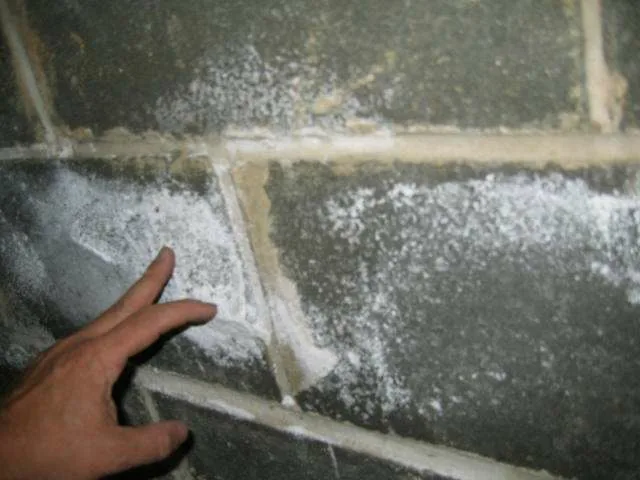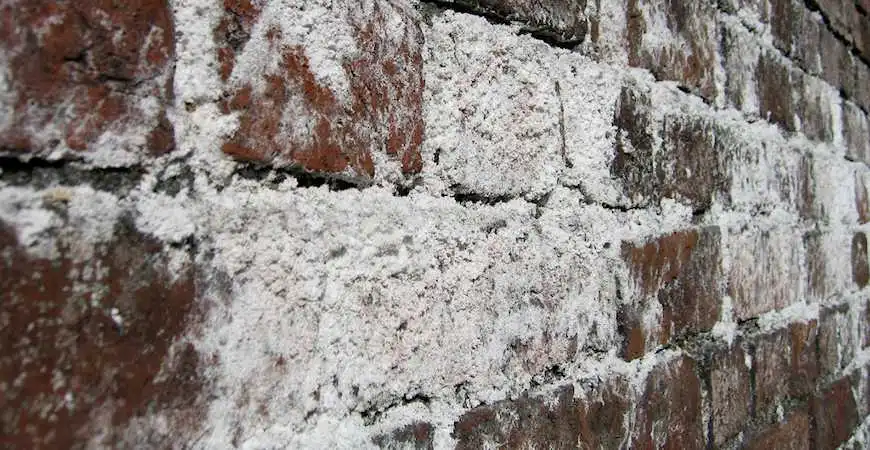Efflorescence in concrete refers to the formation of white, powdery deposits on the surface due to salt leaching. These salts are usually present in the concrete mix or can be introduced by external sources like water. When water dissolves these salts and moves to the surface through capillary action, it evaporates, leaving the salts behind, resulting in efflorescence. It’s a common aesthetic issue in concrete but usually doesn’t affect the structural integrity.
Efflorescence in concrete can occur due to several causes:
- Soluble Salts in Concrete Mix: Presence of soluble salts like calcium, potassium, and sodium in the concrete mix.
- Water Source: Water used in mixing or curing that contains dissolved salts can contribute to efflorescence.
- Incomplete Curing: Inadequate curing or improper drying of concrete can lead to the concentration and migration of salts to the surface.
- Poor Drainage: Water infiltration into the concrete, especially in areas with poor drainage, can dissolve salts and transport them to the surface.
- High Humidity: High humidity levels can contribute to the continual dissolution and migration of salts within the concrete.
- Concrete Porosity: Highly porous concrete allows easier movement of water and salts, increasing the likelihood of efflorescence.

Signs of efflorescence in concrete
- White Powdery Deposits: Visible white or grayish powdery deposits on the surface of the concrete.
- Crystalline Growth: Formation of crystalline structures on the concrete surface, often resembling a salt-like pattern.
- Staining: The presence of stains or discoloration on the concrete caused by the deposited salts.
- Surface Roughness: Efflorescence can sometimes lead to a rough or gritty texture on the concrete surface.
- Flaking: In severe cases, the surface may start to flake or peel due to the crystalline growth.
How to avoid efflorescence in concrete?
To avoid efflorescence in concrete, consider the following preventive measures:
- Use Low-Salt Concrete Mix: Choose concrete mixes with lower soluble salt content to reduce the likelihood of efflorescence.
- Quality Aggregates: Use clean, high-quality aggregates that are free from contaminants and soluble salts.
- Proper Curing: Ensure proper curing of the concrete, using methods such as wet curing or curing compounds to minimize water evaporation.
- Controlled Water Content: Maintain a proper water-to-cement ratio in the concrete mix to prevent excessive water that can dissolve and transport salts.
- Good Construction Practices: Follow best construction practices, including proper drainage design and protection of the concrete during construction to prevent water infiltration.
- Avoid Contaminated Water: Use clean, non-contaminated water for mixing and curing concrete to prevent introducing additional salts.
- Sealants and Coatings: Apply sealants or coatings to the concrete surface to create a barrier that helps prevent water and salt penetration.
- Improve Drainage: Ensure proper drainage around the concrete structure to minimize water infiltration and accumulation.
- Avoid Water Ponding: Prevent water from ponding on the concrete surface, especially during the curing period.
By addressing these factors during the construction process, you can significantly reduce the chances of efflorescence in concrete structures.

How to repair efflorescence in concrete?
To repair efflorescence in concrete, follow these steps:
1. Clean the Surface:
- Use a stiff brush or broom to remove loose efflorescence from the surface.
- Pressure washing with water can help dislodge some efflorescence, but avoid using excessive pressure to prevent damage.
2. Chemical Cleaning:
- Apply a mild acid solution (such as vinegar or diluted muriatic acid) to dissolve and remove remaining efflorescence.
- Follow safety precautions and manufacturer guidelines when using acid solutions.
3. Rinse Thoroughly:
- After chemical cleaning, thoroughly rinse the concrete surface with water to neutralize and remove any remaining acid.
4. Dry the Surface:
- Allow the concrete to dry completely before applying any sealers or coatings.
5. Sealing:
- Apply a breathable sealer to the concrete surface. This helps to repel water and prevent the migration of salts while allowing trapped moisture to escape.
6. Address Water Issues:
- Identify and address the root causes of water infiltration, such as improving drainage or fixing leaks.
7. Repair Cracks:
- Fill any cracks in the concrete to prevent water penetration, which can contribute to efflorescence.
8. Consider Efflorescence-Resistant Products:
- When applicable, consider using efflorescence-resistant concrete mixes or additives in future construction projects.
It’s crucial to note that while these steps can help mitigate efflorescence, the success of the repair depends on addressing the underlying causes of the issue, such as water management and concrete mix quality.
Tips to avoid efflorescence in concrete
To avoid efflorescence in concrete, consider the following tips:
- Use high-quality concrete mixes with low-soluble salt content to minimize the potential for efflorescence.
- Ensure that aggregates used in the concrete mix are clean and free from contaminants or excessive soluble salts.
- Implement proper curing techniques, such as wet curing or curing compounds, to prevent rapid water evaporation and minimize the risk of efflorescence.
- Maintain an appropriate water-to-cement ratio in the concrete mix to avoid excessive water that can dissolve salts.
- Use clean, non-contaminated water for both mixing and curing concrete to prevent introducing additional salts.
- Apply sealants or coatings to the concrete surface to create a barrier that helps prevent water and salt penetration.
- Ensure proper drainage around the concrete structure to minimize water infiltration and accumulation.
- If using admixtures, select those with low or no water-soluble salts to minimize the risk of efflorescence.
Conclusion
When efflorescence does occur, a careful and systematic approach to cleaning, sealing, and addressing underlying causes can help restore the concrete’s appearance and prevent further issues. Regular inspections and maintenance remain vital to ensure the long-term durability and visual appeal of concrete structures. By incorporating these strategies, the impact of efflorescence can be minimized, allowing for structures that not only stand the test of time but also maintain their aesthetic quality.


